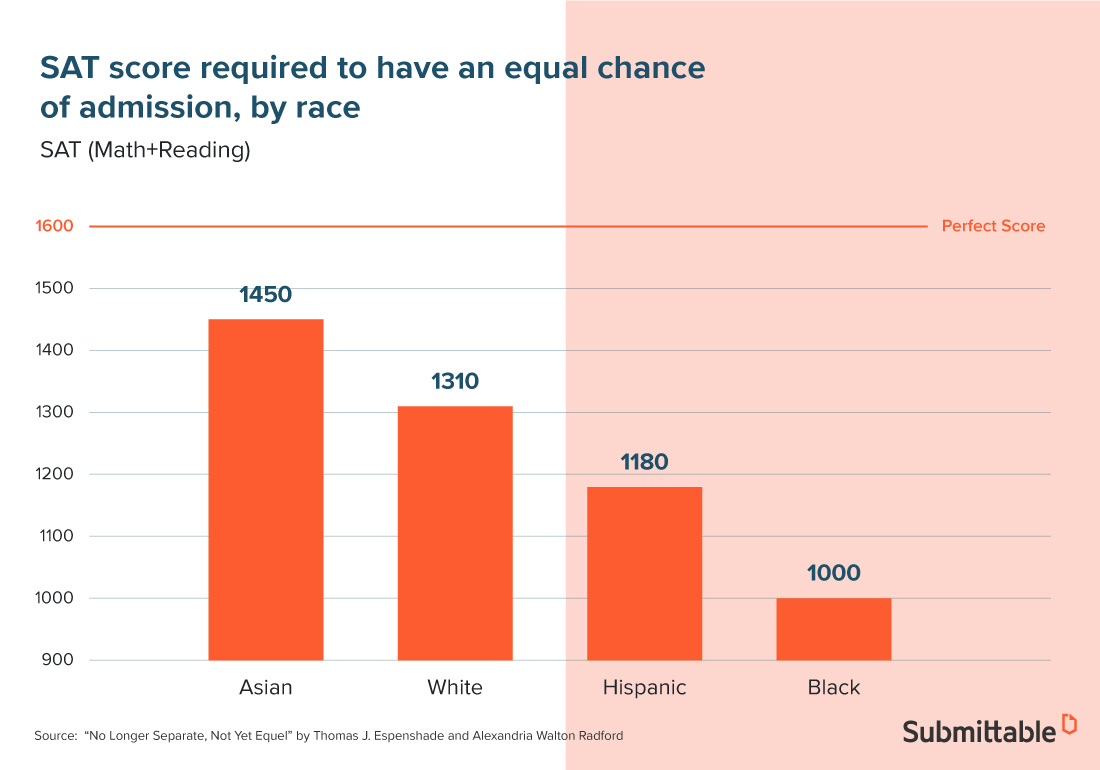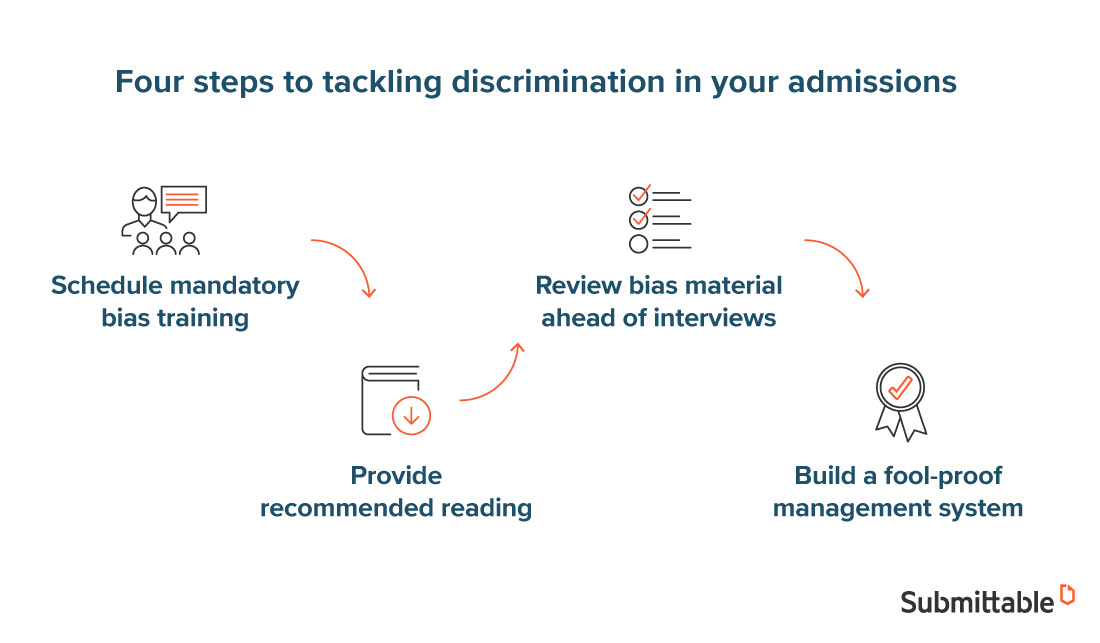In the college admissions review process, there’s room for a lot of things.
Discrimination isn’t one of them.
Sadly, it’s all too easy to let it seep through the cracks if measures haven’t actively been put in place to prevent it.
Discrimination in the college review process hurts both students and the colleges themselves. It limits the students’ educational experience through a lack of interaction with those from different intellectual and social backgrounds.
A diverse student body encourages critical thinking and a challenging of stereotypes and misconceptions – crucial for building a healthy society.
For the colleges themselves, discrimination in the admissions process means a lack of representation, which can sully a college’s reputation. It also does no favors for serving the democratic needs of society.
What discrimination looks like
Ethnicity is an unavoidable part of discrimination.
In their joint book, No Longer Separate, Not Yet Equal, Espenshade and Radford shed light on how discrimination hits ethnic minorities on SAT acceptance rates.
Their research showed that Asian-Americans have the lowest SAT bracket acceptance rate in higher education due to being the most under-represented. They would need to score on average 140 points higher than white students, 270 points higher than Hispanics and 450 points higher than black students.

Lower-income applicants have it tough too, with only 11% of students from low-income families graduating each year, according to the Postsecondary Education Opportunity.
Steps To Tackling Discrimination In Your Admission Process

1. Schedule mandatory bias mitigation training
Get everyone on the same, informed page by setting up compulsory bias mitigation training sessions. You can do these annually (or more frequently if you think it’s necessary) and sessions should include useful evidence-based strategies staff can use to reduce bias in the admissions process.
You can even bring in a specialized coach to break down the complexities of unconscious discrimination into digestible lessons. Discrimination doesn’t always show itself clearly, so educated, useful training sessions will help to shed important light on how to be more aware of it.
Advertise the new sessions in a centralized communication space and more importantly, make it easy for people to register their attendance. Submittable’s signup tool can help with this and is easy to use. You can set up reminders to team members as the date approaches in just a couple of clicks.
Education and awareness are vital to minimizing discrimination. Making sure your entire review team is on the same page and informed is a key first step.
2. Provide recommended reading
The more informed admissions officers are about bias and discrimination, the better equipped they’ll be to combat it.
Gather relevant and up to date research studies on the topic and provide it to staff. You could include these in the bias training sessions or in the admissions manual. It’s important to lead by example here. Have leadership teams actively share their insights on the resources so other teams are encouraged to do the same.
Be sure to regularly refresh the supply. There’s always new information and case studies rolling out so you’ll always have some material to keep the reading list up to date.
There are a handful of online libraries dedicated to research discovery where you can pull hundreds of journals and reference works on given subjects. Wiley Online Library and Questia are great places to start.
3. Review bias material ahead of interviews
Before the interviewer meets with the candidate, have them review a list of strategies to reduce bias. This could be how to manage body language to not asking trick questions where the student would be expected to trip up.
Reviewing material like this right before an interview can help admission officers become more attentive about unintentional bias. Often, people put out certain types of behavior and body language when making stereotypical judgments and they might not be aware of it. Useful and concise material to go over before meeting with candidates can help an interview stay on top of it.
Interviewers should also use the ‘consider the opposite’ strategy. This is when an interviewer makes a decision about an applicant’s qualifications (whether it’s positive or negative) and then gathers the evidence for the opposite.
It’s a sort of ‘re-review’ that helps give applicants a stronger chance when their academic achievements don’t stand alone. A student from a low-funded public school, for example, might not have the exact grades needed but the interviewer might find they’ve excelled in running the debate team or as a mentor to a younger student.
Evaluating an applicant from all sides is a thoughtful way to determine if they’re the right fit or not.
4. Build a fool-proof management system
Tighten up your process and systematically minimize discrimination with a powerful application management system.
With a modern tool to manage your submissions, you won’t get lost in all the details because the software takes care of that for you. You can also take concrete steps toward a more diverse student body and a less biased selection process that is actionable and trackable.
5. Use a holistic approach
Most selective US colleges use a combination of numerical and non-numerical measures to assess a candidate’s suitability.
Students and families are usually familiar with ‘hard factors’, like GPA and test results but admission officers are starting to look at the ‘soft factors’ too. Extracurricular activities, demonstrated interests, essays, and recommendations all work together to help consider a student in their entirety.
Among the schools that self-identified as using the holistic review process, a majority reported an increase in student diversity.
A study by the National Institute on Minority and Health Disparities found that holistic admissions significantly impact student success and that colleges are more likely to track student engagement within the campus and community.
How Submittable can help you minimize the bias
We’re constantly improving our platform and tools to help organizations keep bias and discrimination at bay.
We know the review process in college admissions is a long and complicated one, even without the insidious issue of discrimination. We’ve shared a few ways Submittable can help your institution fight the equity battle.
Expand your review board
First things first. Diversity starts from within.
Having a diverse review board helps create an egalitarian culture where contrasting insights and conversations about diversity are encouraged.
Including more members of staff from varying professional and social backgrounds can help balance judgment and minimize accidental bias. Non-alumni reviewers, in particular, are a safe choice—a recent study showed that alumni reviewers are more likely to favor applicants similar to themselves due to ingroup bias.
Increasing your board size can be a burdensome process but you can simplify the job with our Review Workflow tool. You can create multiple rounds in your review process, engage different sets of reviewers for each applicant and leave notes.
Widen your call for applicants
If you make active efforts to promote your institution on a wider scale, you’re more likely to receive a diverse pool of applicants.
It doesn’t need to be a difficult job. The Discover tool is a searchable platform that puts your institution in front of more people.
You can add tags to your forms (as many as you’d like) so they come up in more searches. Once you’re up and running on the Submittable platforms, you can request to feature on our newsletter, Submishmash Weekly and get in front of an extra 240,000 people every week.
Social media is a great way to attract perspectives from groups you wouldn’t normally have access to. We can also help you narrow down on specific demographics through Facebook so you can reach more diverse student groups.
Organize and track applications
It’s difficult to make a change if you’re not crystal clear on the current situation.
Either during or after your admissions process, it might help to know specific demographic information about your applicants.
The Submittable labels tool auto-populates labels based on the responses selected on the forms. You can then sort your applications and use the information to assess any gaps in the diversity of applicants. This way, you’ll know what groups are under-represented and you can take steps to make the process more inclusive.
Pull reports and share insights
If you’re trying to minimize discrimination in your review process, you’ll need to keep solid records of your progress. The reporting tool on Submittable gives you important insights into the application process so you can keep an eye on results.
You might want to pull a report on how many of your applicants are female, for example, or from a certain ethnic group (as long as you’ve added that on the form). You can create a report on any of the fields the applicant has submitted to view, save or export.
Sharing the reports with the internal team can help shed light on progress and keeps the conversation of diversity flowing. You can also share reports publically to create transparency within your organization and spread the word on your goals of minimizing discrimination.
Moving towards a more just review system
Discrimination has always been a pesky aspect of the college admissions review process.
A big part of it often boils down to unconscious bias and that’s why you need to actively put a plan in place to help create a more equitable reviewing process.
These tools and tips are by no means an exhaustive list on how to tackle discrimination but it’s a solid start in encouraging a proactive approach to building a more inclusive review.
